|
Human prehistory and early history in the Choke Canyon region, as well as more generally throughout
south Texas, are divided into four broad cultural-chronological divisions. Earliest known settlement
was during the Paleoindian era from at least 13,500 years ago through about 10,000 years ago (11,500-8,000
B.C.). We did not find any buried Paleoindian sites, but scattered finds of distinctive lanceolate
projectile points in upland areas, of types such as Folsom, Plainview, and Scottsbluff, show that early peoples knew the
area. Most traces of their presence are either very deeply buried along the rivers or, were scoured out
by floods and picked over by later peoples including the many modern artifact collectors over the last
century.
Much more common at Choke Canyon were sites dating to the Archaic era, from 10,000 years ago to about
a thousand years ago. Typical stone artifacts include dart points, knives, grinding stones, and gouges (adzes).
Dart points were used to tip short spears thrown with an atlatl or spear thrower, the main hunting
weapon used during the entire Archaic period. Some dart points were also used knives. Metates
(grinding slabs) and manos (hand grinders) were necessary for cracking and grinding up the many seeds,
beans, and nuts collected by gatherers. Gouges are believed to have been woodworking tools used for cutting, scraping, and shaping wooden artifacts of many different kinds. But they were also the
ancient equivalent of a Swiss army knife in today's world, multipurpose tools sometimes used to shape bone and antler, and scrape hides. Archaic people also made and used stone
smoking pipes, usually just simple tubular ground stone affairs. True tobacco and jimsonweed are possible
substances smoked in these pipes. The Archaic tool kit also contained chipped stone knives (thin bifaces)
and hide scrapers (unifaces).
Antler and bone were used for flaking tools, awls, needles, and other
implements. Ornaments and ritual objects were made from marine shell, mussel shell, bone, and antler ornaments.
Archaic people would have had a very extensive array of baskets and other woven containers, but they had
no clay pottery. Most of the things they used would have been made of perishable materials-plant fiber,
wood, and leather: mats, carrying nets, rabbit nets, cord, sandals, clothing, and much more. None of
these things are preserved in the archeological record of the area, but many have been found in the dry
caves not far to the west and were mentioned by Spanish explorers.
The Late Prehistoric period, from about 1000 years ago until the Spanish arrived in the 16th century,
is marked by the advent of the bow-and-arrow and the introduction of pottery. Arrows were tipped with a
very small chipped stone points, often mistakenly called "bird points," even though they were used to
bring down buffalo and sometimes people. Distinctive chipped stone knives, known as "beveled knives,"
are typical of the period. "Snub nosed" unifacial tools were used as hide scrapers.
Earthenware pottery bowls and jars, most undecorated, were made and used by Late Prehistoric people. The pottery appeared mainly
in "earth tones" of tan, brown, or reddish-orange, and was used haul and store water and food,
for cooking and as serving dishes. Pottery vessels supplemented traditional containers made of wood, basketry, and
gourds.
Other than adding bows-and-arrows and pottery, the Late Prehistoric people at Choke Canyon lived in
much the same way as their Archaic forbears, as hunter-gatherers living off the natural bounty of
the land. The common occurrence of arrow points, pottery, beveled knives, and unifacial stone hide
scrapers with buffalo bones points to the importance of bison in the Late Prehistoric economy of Choke
Canyon. This same pattern of buffalo exploitation, and attendant tool technology, is
seen in many other areas of Texas at roughly the same time, beginning around A.D. 1200 or so. Yet at the Possum Hollow site, Choke Canyon's most thoroughly sampled Late Prehistoric site, excellent bone preservation showed that deer and antelope provided more meat than did bison.
We can safely assume that prehistoric people living in the Choke Canyon area had many other tools and
items of clothing made out of wood, fiber, and animal skins and hides. The Lower Pecos region, where dry
rock shelters have preserved such perishable artifacts, gives good insights into how the people of south
Texas were likely equipped. The durable objects of stone, bone, and shell discussed above by no means
represent all of the possessions that these people had to make their living as hunter-gatherers.
Virtually all of the chipped stone tools mentioned above had handles or shafts made of wood. Archaic dart
points were mounted on shafts and foreshafts of wood, and the atlatl was made of wood as well. Bows and
arrow shafts were made of wood. Fire was made using a small "bow drill," and a wooden anvil. A whole
array of baskets, mats, sandals, netting, and cordage were made out of plant fibers. Animal hides and
furs were made into items of clothing, cloaks, and blankets. Due to the fact that most Choke Canyon and
south Texas prehistoric sites were out in the open, these materials do not survive in the archeological
record, and we can only speculate that they existed, based mainly on what we see in Lower Pecos sites not
far to the northwest on the Rio Grande and Pecos.
Native American peoples were still living in the Choke Canyon area in the early Historic era, in the 16th
through 18th centuries. Artifacts such as metal arrow points, iron knife blades, and colorful glass trade
beads show that native people were in contact with the early European invaders, especially the Spanish.
Prehistoric people in Texas had no metal artifacts and no knowledge of metallurgy, nor did they possess
glass of any type (except a few traded pieces of obsidian, a natural volcanic glass). European-made goods show up in late aboriginal sites, evidence of direct, or indirect, contact. Native peoples quickly adapted to arrival of horses, and horse-related paraphernalia such
as bits and bridle and saddle parts sometimes show up in aboriginal sites. But the arrival of Old World peoples also brought
diseases, guns, and an overwhelming sea of changes for native peoples, as the newcomers made the region their own.
Investigations
Beginning in 1977, and continuing for the next five years, teams of archeologists from the University
of Texas at San Antonio (UTSA), Texas A&M, and Texas Tech investigated over 400 archeological sites
distributed over 38,000 acres of land that would soon become the Choke Canyon Reservoir on the Frio River.
The planning and construction was overseen by the United States Bureau of Reclamation. The Center for
Archaeological Research at UTSA carried out most of the archeological research. Additional work was accomplished by two field schools during the summer of 1981. One was a six-week UTSA undergraduate field school, while the other was an intensive one-week field school attended by 271 members of the Texas Archeological Society. The
major five-year period of investigation was preceded by an original archeological survey conducted by the
Texas Historical Commission in the early 1970's and site recording done by several avocational
archeologists.
A tremendous amount of archeology was done at Choke Canyon by the time a dam was completed on the Frio
River and the lake began to fill up. Combined data would show that the Choke Canyon area of south Texas was
occupied from PaleoIndian times on, but human activity was most heavily indicated during the long 9,000-year
span of the Archaic.
Reviews of three of the most thoroughly investigated prehistoric sites at Choke Canyon help
characterize the prehistoric archeology of the region and the lifeways of the area's hunter-gatherer
inhabitants. Two of the sites—Possum Hollow (41LK201) and the Gates-Rowell Site (41LK31/32)—
are now underwater at the main body (east end) of Choke Canyon Reservoir. The other site—
Skillet Mountain No. 4 (41MC222)—is at the west end of the lake, not far from Tilden, Texas.
Possum Hollow and Gates-Rowell were eventually both largely destroyed as earthen fill for the Choke Canyon
Dam was mined from borrow areas encompassing the sites. Skillet Mountain No. 4 was a thin site not used
for long and it had been damaged as well as revealed by land-clearing while the UTSA archeologists were working nearby.
|
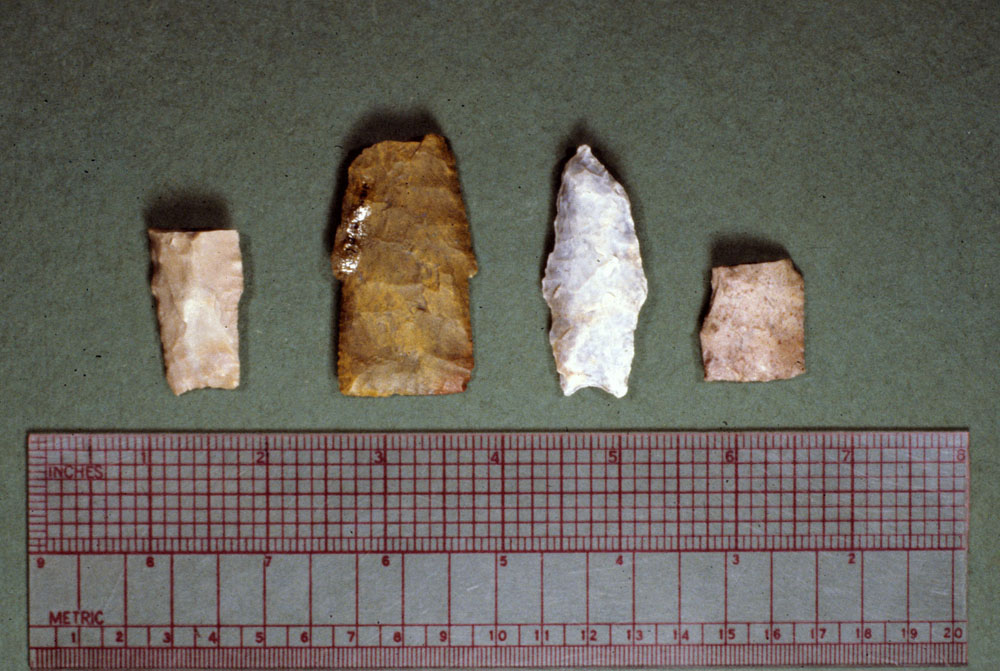
Late Paleoindian and Early Archaic dart points from Choke Canyon. No buried Paleoindian sites were found, probably because they were either washed away or deeply buried by Archaic-period floods. Collectors have found Early Paleoindian artifacts such as Clovis and Folsom points in the surrounding uplands and there is little doubt that these peoples would have also frequented the ancient Frio River.  |
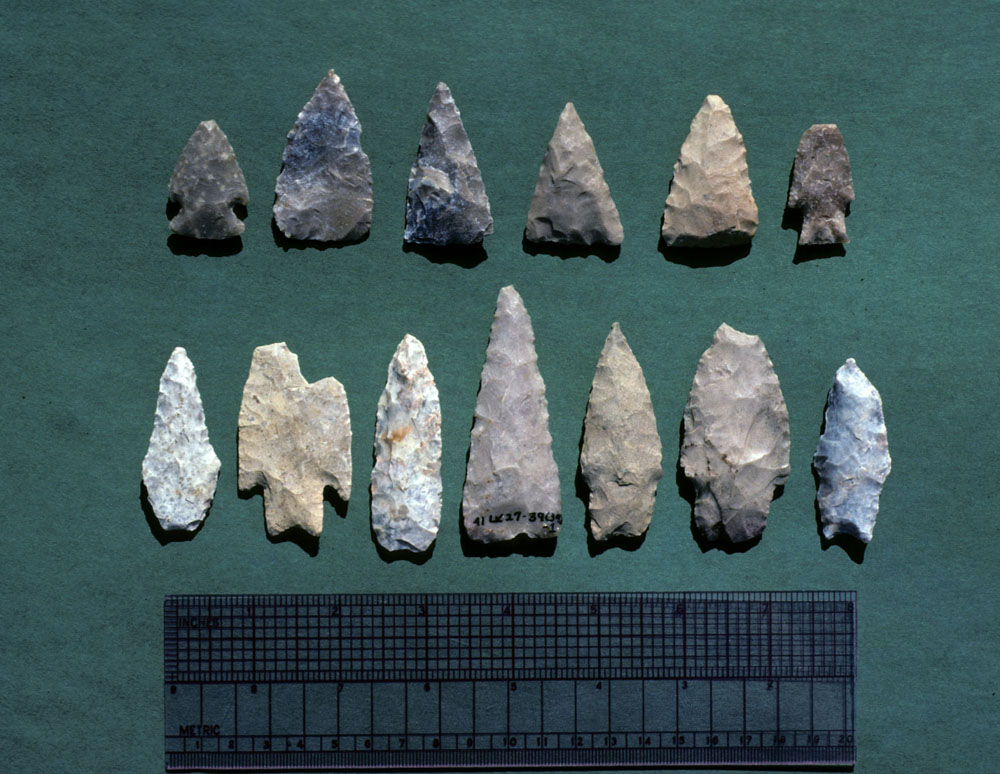
Many Archaic dart points from Choke Canyon are stemmless triangular forms that are hard to assign to a time period. Stemmed dart points were less common, but easier to date by comparison to the better-known Edwards Plateau.  |
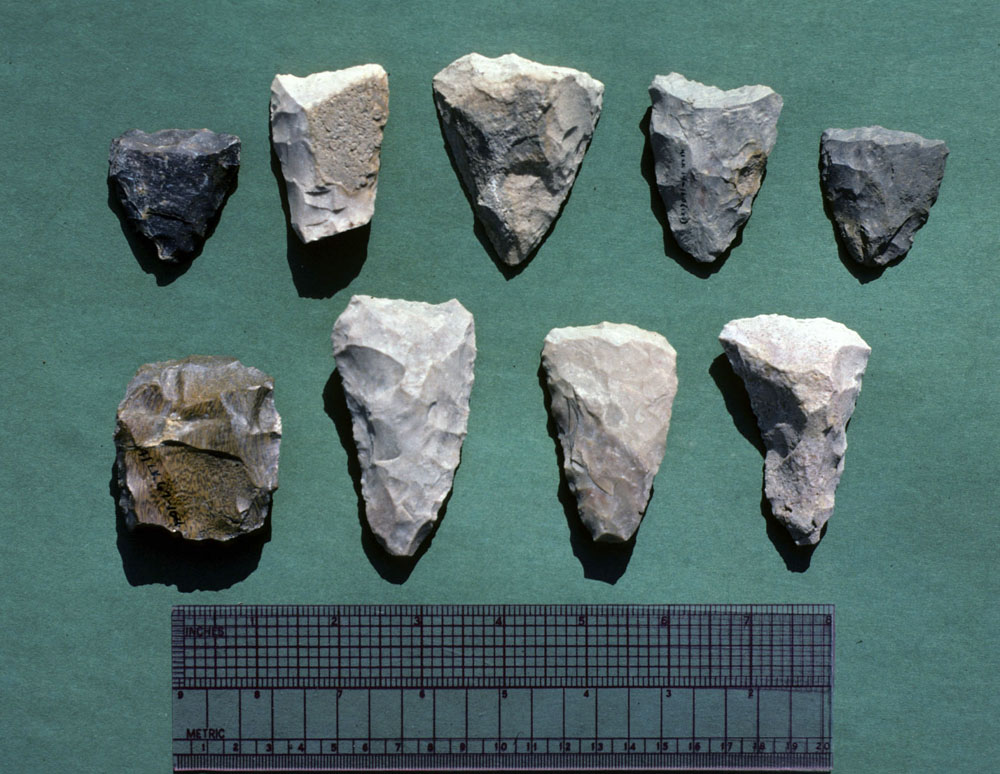
"Gouges" were very common at Choke Canyon and most are thought to have been woodworking tools, perhaps better characterized as adzes.  |
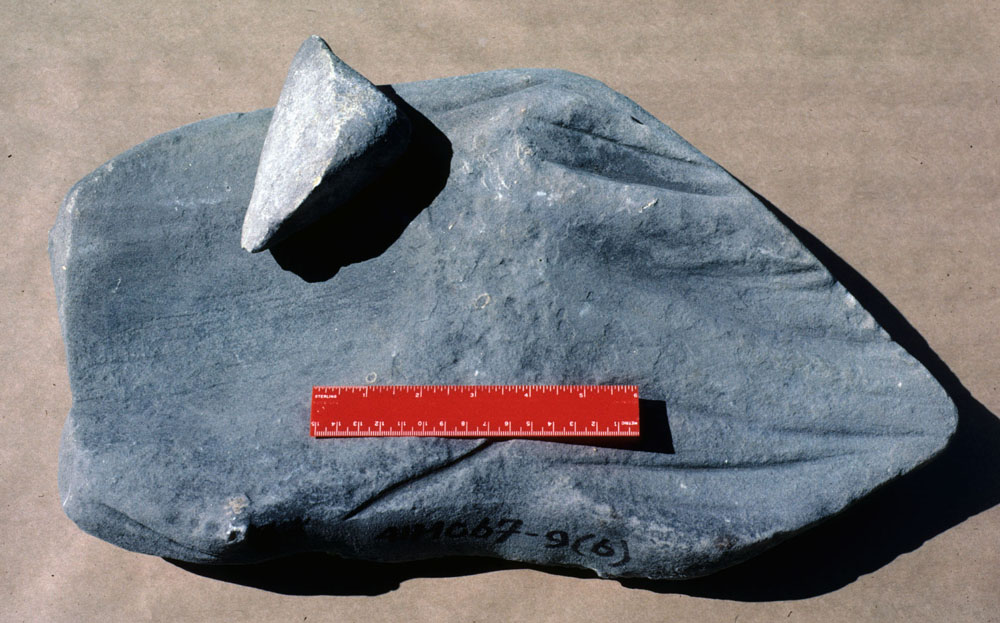
Hand stones and grinding slabs and ("manos and metates") were found at many Choke Canyon sites. Most of these were made from local sandstone and represent plant-processing tools used to pulverize seeds and nuts. The grooves were likely used to sharpen and shape wood and bone, as well as grind the edges of chipped-stone tools during flintknapping.  |
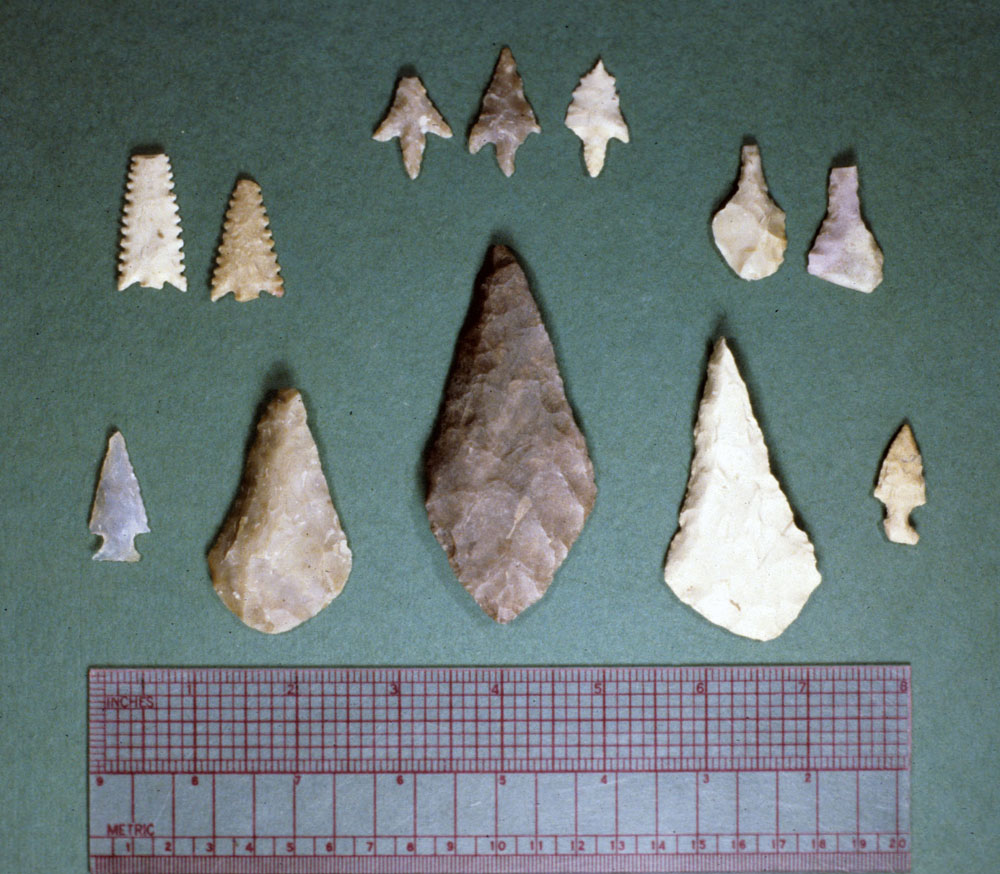
Chipped stone artifacts dating to the Late Prehistoric period, which began about 1200 years ago (A.D. 800).  |
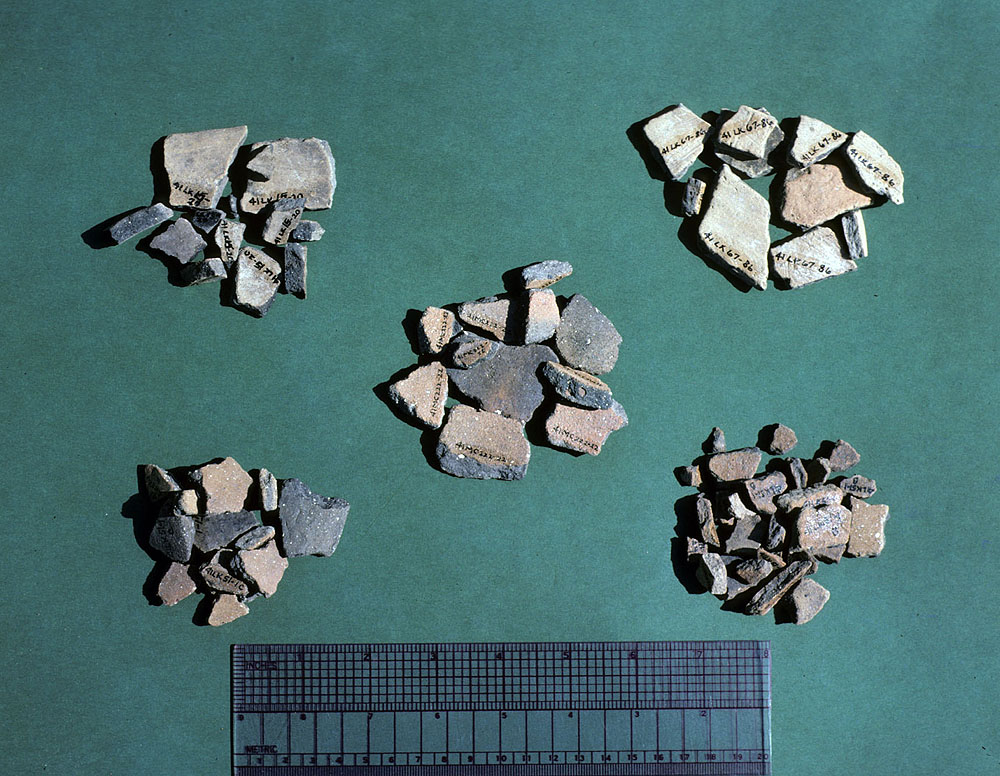
Bone-tempered earthenware pottery sherds were found at several Choke Canyon sites. They date to the Late Prehistoric as early as the 12th century.  |
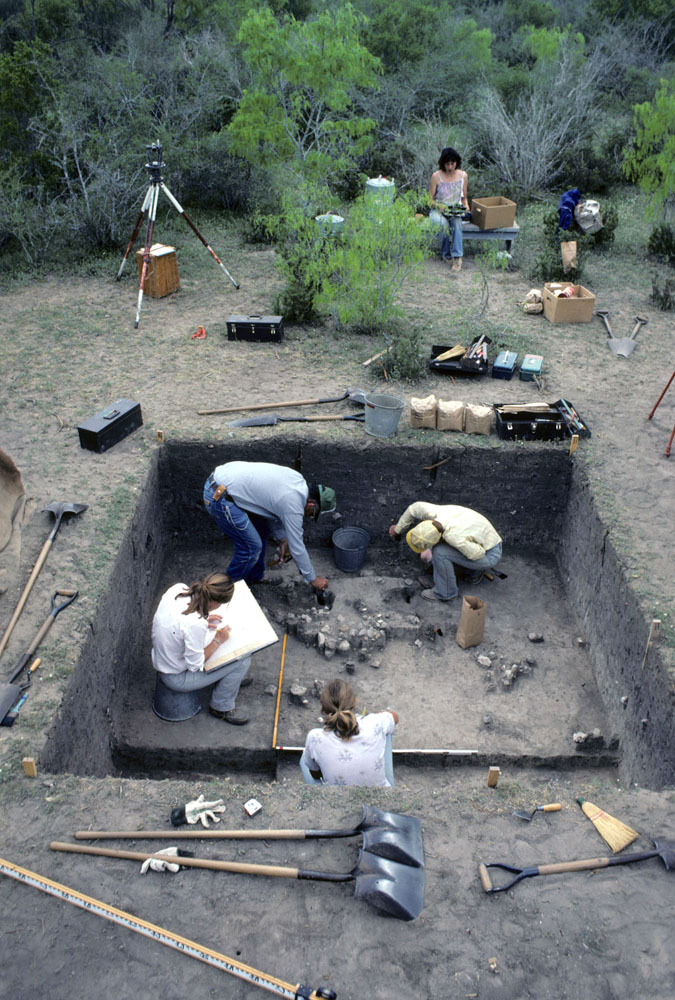
Archeologists documenting a Late Archaic hearth at site 41LK53.  |
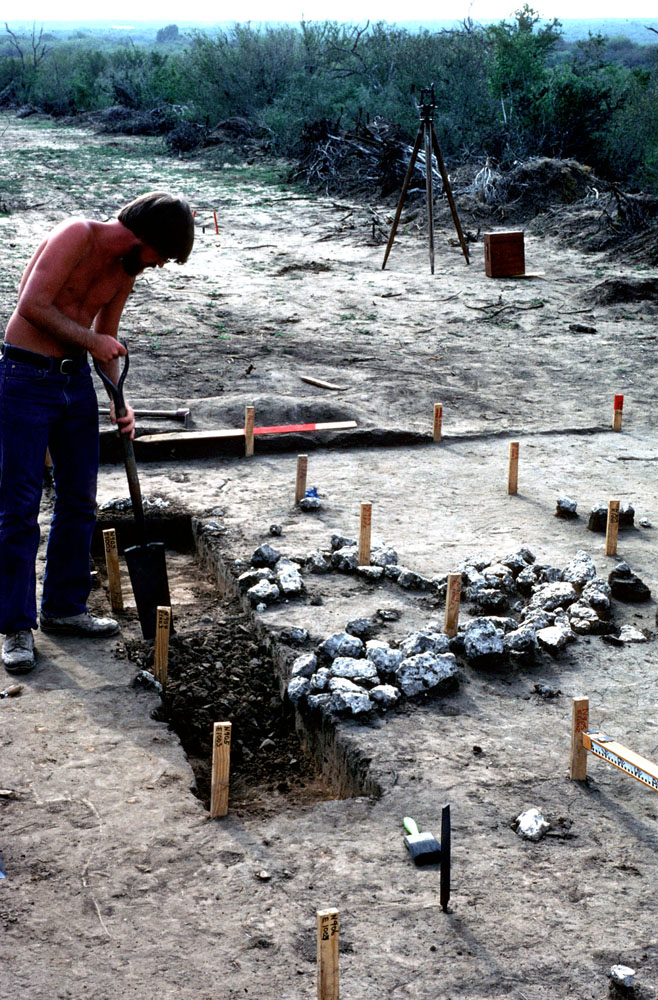
Archeologist Steve Black excavates a narrow trench to document the cross-section of a hearth feature at site 41LK67.  |
|